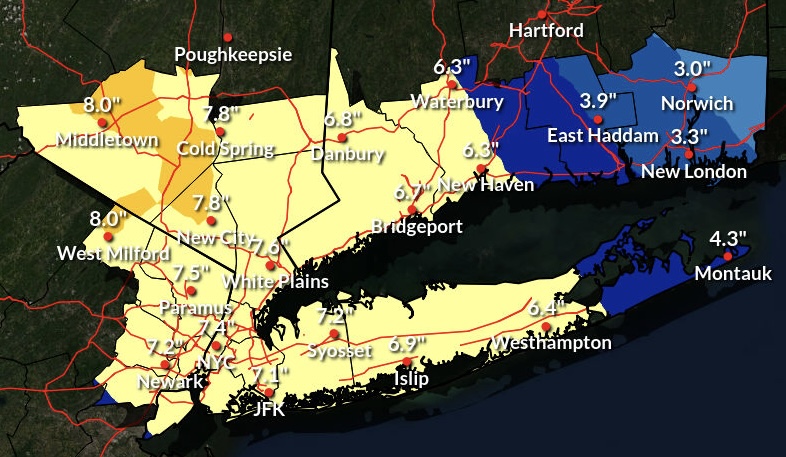No Cut at Mecox and the Shape of Modern People

This column is about how out of shape people are these days compared to years ago. The comparison is to 400 years ago.
When the English settlers first arrived in the Hamptons in 1640, they saw that water in a pond near the ocean would overflow after a big rain and make the land around it a swamp unfit for farming. They wanted it to be farmland. Noting that one end of it was just 100 yards from the ocean, they decided that when the water got too high, they’d ring the church bell and get all the able-bodied men in the community down to the beach with shovels to dig a trench in the sand to cause the pond to let into the ocean.
The rushing water would continue for days, then slow and stop, at which time the pond, now at a proper level, would heal itself.
Letting that pond and others nearby now happens about twice a year and continues on to this day. And it is done when the decision is made by the Southampton Town Board of Trustees, a government body selected by the townspeople in local elections, ordered into effect by the King of England in an edict in 1686. The ponds regulated are Mecox Bay, Georgica Pond and Sagg Pond.
In the early days, if you didn’t show up with a shovel, you’d be fined or even given jail time. In the most recent 100 years, however, the work gets done using earthmoving equipment. Steam shovels, bulldozers, earthmovers. No volunteers needed, and so no fines or punishments.
The trustees make money when they make the cut. Several tons of sand are dug and piled up. Nearby oceanfront homeowners pay the trustees to dump the sand in front of their houses to strengthen the dunes protecting the houses from the sea. The fact is, the trustees need money. They are separate from the town, and must raise their own funds for the repair and keeping of what they are responsible for — docks and piers, pond bottoms, shellfish, ocean beaches, and certain roads. So ordered the king.
Beginning around 2010, however, the State of New York and the U.S. government, which had earlier created agencies to regulate various environmental activities, began to zero in on the pond letting. Here were these trustee people regulating water levels, salinity, shellfish health, and fish stocks. Who do they think they are?
Though this was just moving water from one place to another, now forms had to be filled out, approvals requested, permits given, activities regulated.
At first, the New York State Department of Environmental Conservation gave the trustees permits good for 10 years. But then newer officials decided the permits would expire after five. Bureaucrats are always looking for more work to do.
Permits in 2021 were delayed by the bureaucrats for one reason or another. The let was finally approved, but only on an emergency basis.
And then came 2022. In April of that year the ponds again needed to be let. But now the NYSDEC stopped the work for another reason: It would violate the Threatened and Endangered Species Program. A male and female piping plover bird had built a nest within 20 feet of where the cut at Mecox would go through. It’s a crime to disturb a piping plover nest.
You can go to jail if you disturb a piping plover nest. Piping plovers are a threatened species. This overrode anything the Southampton Town Trustees or anybody else might want to decide. Very specifically, the loud, scary noises emitted by heavy machinery on the beach could not happen until the piping plovers and hatched babies flew away in August.
What to do?
Well, the trustees put out a call for volunteers. Volunteers with shovels. Four hundred years later, they’d make the cut the old-fashioned way. And quietly.
And so there they were, assembled on the morning of June 18, 2022. And they began digging.
But as the work proceeded, news arrived that a harbor seal had just waddled up injured or exhausted onto the beach at Shinnecock 20 miles away. He’d need help. Some of the volunteers at Mecox left.
The remaining volunteers, however, continued digging and digging, until finally, the trench was made — narrower than it would have been with the machinery — and as the last shovelful of sand connecting the pond with the ocean was heaved aside, the water began coursing down the trench into the sea. Twenty minutes later, the flow stopped. Sand had begun collapsing into the trench. They’d have to dig further.
But nobody felt up to doing that. The volunteers were exhausted. The men of 1640 could do it. The men (and women, lest we forget) of 2022 could not.
I read this story aloud to a historian friend to confirm the accuracy of it. And he said that there was another reason the men of 1640 could do it while those of 2022 could not.
“What?”
“Mules. The settlers had mules that could drag a plow. The mules would join in the effort back in 1640.”
Oh. And why am I even writing this column?
Maybe today we should have a stall for a mule behind the trustees’ offices. Just in case this happens again.
Of course, nobody but the trustees is allowed to let these ponds. No exceptions. Except once, there was.
On a summer’s day in 1998, President Bill Clinton and First Lady Hillary arrived to stay the weekend at Steven Spielberg’s private estate facing Georgica Pond. The U.S. Secret Service fretted. Reporters, curiosity seekers, and terrorists could freely paddle kayaks in the pond. Something would have to be done.
The next morning, Georgica Pond was gone. Where the pond had been was just a big, wet, smelly mud flat three miles long and one mile wide. It was said that the Secret Service had ordered it done. Might have brought in the military during the night. But nobody could prove it and nobody was saying.
Georgica Pond remained a big smelly mud pile for nearly a year. But hey, it had been done for the president. It was the patriotic thing to do.
BREAKING NEWS: I’ve just learned that this year the Southampton Trustees will have their budgets listed on town tax bills for the first time. The public will now see what is spent. I hope the trustees in Southold and East Hampton make similar arrangements.
Read more of Dan Rattiner’s stories









